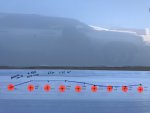Hi All,
I am looking to come up with a solid load for my 6.5 creedmoor. It has a 26 inch tube with 1-7.5 twist. Berger 140 hybrids, H4350, Lapua brass and a CBTO of 2.0920.
In an effort to save time, $, and barrel life; I tried the Scott Satterlee method. Here are the results....
I think it shows the velocity curve, but I am not sure where the best node would be.
Your thoughts, suggestions are welcome.
Thanks, Mike
I am looking to come up with a solid load for my 6.5 creedmoor. It has a 26 inch tube with 1-7.5 twist. Berger 140 hybrids, H4350, Lapua brass and a CBTO of 2.0920.
In an effort to save time, $, and barrel life; I tried the Scott Satterlee method. Here are the results....
I think it shows the velocity curve, but I am not sure where the best node would be.
Your thoughts, suggestions are welcome.
Thanks, Mike


